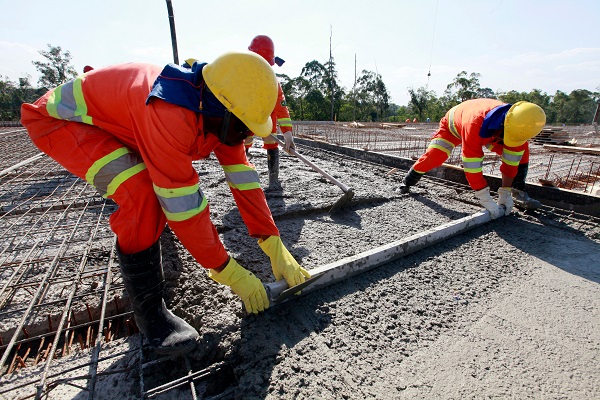Injuries Caused by Concrete and Cement on New England Construction Sites

Construction workers in New England face a wide range of risks and hazards every day on the job. In fact, 1 out of 5 workplace fatalities nationwide involve construction accidents, according to the Bureau of Labor Statistics (BLS).
While there are many common causes of construction accidents in New England, many of them involve concrete and cement. So, what makes these materials so dangerous? Our legal team at the Law Offices of Deborah G. Kohl in Massachusetts and Rhode Island explains.
Common construction injuries involving concrete and cement
Concrete and cement often cause serious injuries to construction workers due to the potentially hazardous components in both building materials. Such workplace injuries often include:
- Eye injuries due to cement or concrete coming into contact with a construction worker’s eye.
- Chemical burn injuries due to concrete or cement coming into direct contact with the skin.
- Respiratory injuries or illnesses, including asthma, due to inhaling hazardous materials often found in concrete or cement, including alkaline compounds such as lime (calcium oxide) and crystalline silica.
- Back injuries due to lifting or moving cement or concrete, which can be extremely heavy in solid form.
- Slip, trip, and fall injuries, especially if someone steps in wet concrete or cement.
- Machine-related injuries, such as broken bones caused by being struck by heavy equipment or power tools used while working with cement or concrete.
- Work-related injuries involving rebar, the sharp metal rods often pointing up out of concrete at construction sites.
Causes of accidents involving concrete
New England construction sites can be dangerous due to a wide range of hazards. This is why construction companies need to take steps to prevent injuries involving concrete or cement. Unfortunately, many construction companies don’t take the necessary precautions, resulting in a serious injury involving cement or concrete. Common causes of such injuries include:
- Failing to provide construction workers with safety equipment, such as protective eyewear, respirators, gloves, and sturdy boots that prevent cement from getting inside.
- Not training construction workers on how to safely use concrete or cement.
- No warning signs indicating that cement or concrete is being used at a construction site.
- Poor lighting or poor maintenance, resulting in someone tripping and falling over concrete or into wet cement.
- Failing to provide construction workers with mandatory rest breaks. This is especially important when working with cement or concrete since such work can often be physically exhausting.
What laws govern construction workers handling concrete or cement?
The Occupational Health and Safety Administration (OSHA), a federal agency, has many laws governing the use of concrete and cement at construction sites. These laws are designed to protect construction workers and prevent construction accidents involving cement or concrete. Such laws include:
- OSHA 1926 Subpart Q, which contains many rules and regulations for the use of concrete in masonry construction. Such rules include what tools or equipment must be used, as well as OSHA requirements involving precast concrete, lift slabs, and masonry construction.
- OSHA Standard 1926.701(f), which has specific guidelines for how cement can be applied if using a pneumatic hose. In such cases, construction workers must wear protective head and face equipment.
- OSHA Standard 1926.701(a), which has strict rules involving construction loads. Specifically, before placing any construction materials on concrete, the person responsible and qualified in structural design must verify that the concrete structure is capable of supporting the load.
- OSHA Standard 1926.701(e), which prevents supporters from working under loads of concrete buckets while they are being lowered or raised into position.
What should construction workers do after an accident?
Construction companies must respond immediately if an employee sustains an injury due to working with cement or concrete. While such steps will vary from one accident to another, common responses should include:
- Call 911 and ask for medical attention right away, especially if a construction worker sustains a potentially life-threatening injury involving cement or concrete.
- Stop work on the construction site, especially if other workers could be hurt while working with concrete or cement.
- Tell a supervisor right away that a construction accident occurred involving concrete or cement.
- Ensure that an ambulance or other emergency medical workers can easily access the construction site so there’s no time wasted treating the injured worker.
- Construction companies should carefully document what happened as soon as possible.
- OSHA should be notified as soon as possible. That way, OSHA can begin investigating the construction accident right away.
Contact a construction accident lawyer
Construction accidents involving cement and concrete in Rhode Island, Massachusetts, and other New England states often result in serious injuries. As a result, injured construction workers might have difficulty getting the financial compensation and support they deserve. That’s because construction companies sometimes deny doing anything wrong because they don’t want to be held responsible for the worker’s injuries.
Whatever the circumstances of your work injury, an experienced construction accident lawyer at the Law Offices of Deborah G. Kohl can help you fully understand your legal rights and the potential options available to you.
Make sure your construction injury gets the attention it deserves. Contact our law firm and schedule a free evaluation with a construction accident attorney focused on winning your case. We handle injury claims involving injured construction workers throughout Rhode Island and Massachusetts.
